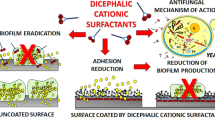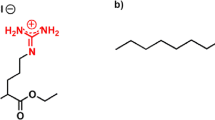Abstract
Candida yeasts are opportunistic pathogens responsible for infections in immunocompromised individuals. Among the virulence factors present in these yeasts we can mention the ability to adhere to host cells, exoenzyme production and germ tube formation. Several compounds, such as antifungal agents, plants extracts, protein inhibitors and surfactants, have been tested regarding their capacity in inhibit Candida spp. virulence factors. Among these compounds, a significant lower number of works are focused on the inhibition action caused by different types of surfactant. The present work aimed to evaluate the effect generated by the surfactants cetyltrimethylammonium chloride (CTAC), sodium dodecyl sulfate (SDS), N-hexadecyl-N–N′-dimethyl-3-ammonio-1-propane-sulfonate (HPS) and octylphenoxypolyethoxyethanol (Triton X-100) on the viability, adhesion ability and exoenzyme production by Candida species. CTAC and HPS were capable to inhibit Candida spp. growth at very low concentrations. All surfactants demonstrated to be capable to inhibit the adhesion of Candida species to buccal epithelial cells (BEC) and the proteinase production. On the other hand, the phospholipase production remained unaltered after the treatment with these compounds. The present data denote that cationic and zwitterionic surfactants are interesting prototypes of inhibitory agents against Candida spp., which is probably associated with the cationic punctual charge of both surfactants. The results are discussed in details in agreement with recent reports from literature.
Similar content being viewed by others
References
Resende MA, Franco LVN, Oliveira RCBW, Koga-Ito CY, Lyon JP. Prevalence and antifungal susceptibility of yeasts obtained from the oral cavity of elderly individuals. Mycopathologia. 2006;162:39–44.
Lyon JP, Costa SC, Totti VMG, Munhoz MFV, Resende MA. Predisposing conditions for Candida spp. carriage in the oral cavity of denture wearers and individuals with natural teeth. Can J Microbiol. 2006;52:462–7.
Pinto PM, Oliveira RCBW, Lyon JP, Cury VF, Arantes RR, Koga-Ito CY, Resende MA. In vitro antifungal susceptibility of clinical isolates of Candida spp. obtained from patients with different predisposing factors to candidosis. Microbiol Res. 2008; 163:579–585.
Ruhnke M. Epidemiology of Candida albicans infections and role of non-Candida-albicans yeasts. Curr Drug Targ. 2006;7:495–504.
Ghannoum MA. Potential role of phospholipases in virulence and fungal pathogenesis. Clin Microbiol Rev. 2000;13:122–43.
Sugita T, Kurosaka S, Yajitate M, Sato H, Nishikawa A. Extra cellular proteinase and phospholipase activity of three genotypic strains of a human pathogenic yeast, Candida albicans. Microbiol Immunol. 2002;46:881–3.
Staab JF, Bradway SD, Fidel PL, Sundstrom P. Adhesive and mammalian transglutaminase substrate properties of Candida albicans Hwp1. Science. 1999;283:1535–8.
Kimura LH, Pearsall NN. Adherence of Candida albicans to human buccal epithelial cells. Infect Imunnol. 1978;21:64–8.
Samaranayake LP, Mac Farlane TW. Factors affecting the in vitro adherence of fungal oral pathogen Candida albicans to epithelial cells of human origin. Arch Oral Biol. 1982;27:873–82.
Ghannoum M, Abu Elteen K. Correlative relationship between proteinase production, adherence and pathogenicity of various strains of Candida albicans. J Med Vet Mycol. 1986;24:407–13.
Fukazawa Y, Kagaya K. Molecular bases of adhesion of Candida albicans. J Med Vet Mycol. 1997;24:87–99.
Dorocka-Bobkowska B, Konopka K, Düzgüne N. Influence of antifungal polyenes on the adhesion of Candida albicans and Candida glabrata to human epithelial cells in vitro. Arch Oral Biol. 2003;48:805–14.
Koga-Ito CY, Lyon JP, Vidotto V, de Resende MA. Virulence factors and antifungal susceptibility of Candida albicans isolates from oral candidosis patients and control individuals. Mycopathol. 2006;161:219–23.
Lyon JP, Resende MA. Correlation between adhesion, enzyme production, and susceptibility to fluconazole in Candida albicans obtained from denture wearers. Oral Surg Oral Med Oral Pathol Oral Radiol Endodontol. 2006;102:632–8.
Lyon JP, Resende MA. Evaluation of adhesion to buccal epithelial cells in Candida species obtained from denture wearers after exposure to fluconazole. Mycoses. 2007;50:21–4.
Argimón S, Wishart JA, Leng R, Macaskill S, Mavor A, Alexandris T, Nicholls S, Knight AW, Enjalbert B, Walmsley R, Odds FC, Gow NAR, Brown AJP. Developmental regulation of an adhesin gene during cellular morphogenesis in the fungal pathogen Candida albicans. Eukaryot Cell. 2007;6:682–92.
Odds FC. Candida and Candidosis. 2nd ed. London: Bailliere Tindall; 1988.
Calderone RA, Fonzi WA. Virulence factors of Candida albicans. Trends Microbiol. 2001; 9:327–335.
Price MF, Cawson RA. Phospholipase activity in Candida albicans. Saboraudia. 1977;15:179–85.
Price MF, Wilkson ID, Gentry LO. Plate method for detection of phospholipase activity in Candida albicans. Saboraudia. 1982;20:7–14.
Barrett-Bee K, Hayes Y, Wilson RG, Riley JF. A comparison of phospholipase activity, cellular adherence and pathogenicity of yeasts. J Gen Microbiol. 1985;131:1217–21.
Cassone A, De Bernardis F, Mondello F, Ceddia T, Agatensi L. Evidence for a correlation between proteinase secretion and vulvovaginal candidosis. J Infect Dis. 1987;156:777–83.
Borg M, Ruchël R. Expression of extracellular acid proteinase by proteolitic Candida. spp during experimental infection of oral mucosa. Infect Immunol. 1988;56:626–9.
Shimizu MT. Produção de hialuronidase, condroitin-sulfatase, proteinase e fosfolipase por amostras de Candida albicans e sua correlação com virulência para camundongos inoculados experimentalmente. Thesis. 105 p. Faculdade de Odontologia de São José dos Campos. 1990.
De Bernardis F, Mondello F, San Millan R, Pontòn J, Cassone A. Biotyping and virulence properties of skin isolates of Candida parapsilosis. J Clin Microbiol. 1999;37:3481–6.
Kwon-Chung KJ, Lehman D, Good C, Magee PT. Genetic evidence for role of extra cellular proteinase in virulence of Candida albicans. Infect Immun. 1985;49:571–5.
Samaranayake LP, Raeside JM, Macfarlane TW. Factors affecting the phospholipase activity of Candida species in vitro. J Med Vet Mycol. 1984;22:201–7.
Ibrahim AS, Mirbod F, Filler SG, Banno Y, Cole GT, Kitajima Y, Edwards JE, Nozawa JY, Ghannoum MA. Evidence implicating phospholipase as a virulence factor of Candida albicans. Infect Immunol. 1995;63:1993–8.
Kurnatowska AJ. Activity of hydrolytic enzymes of Candida albicans strains isolated from patients with periodontal and membrane mucosa of oral cavity diseases. Mycopathol. 1998;141:105–9.
Blanco MT, Morales JJ, Lucio L, Perez-Giraldo C, Hurtado C, Gomez-Garcia AC. Modification of adherence to plastic and to human buccal cells of Candida albicans and Candida dubliniensis by a subinhibitory concentration of itraconazole. Oral Microbiol Immunol. 2006; 21:69–72.
Egusa H, Ellepola ANB, Nikawa H, Hamada T, Samaranayake LP. Exposure to subtherapeutic concentrations of polyene antifungals suppresses the adherence of Candida species to denture acrylic. Chemother. 2000;46:267–74.
Ellepola AN, Samaranayake LP. Adhesion of oral Candida albicans to human buccal epithelial cells following limited exposure to antifungal agents. J Oral Pathol Med. 1998;27:225–32.
Johann S, Soldi C, Lyon JP, Pizzolatti MG, Resende MA. Antifungal activity of the amyrin derivatives and in vitro inhibition of Candida albicans adhesion to human epithelial cells. Lett Appl Microbiol. 2007;45:148–53.
Vasconcelos LCS, Sampaio FC, Sampaio MCC, Pereira MSV, Higino JS, Peixoto HP. Minimum inhibitory concentration of adherence of Punica granatum Linn (pomegranate) gel against S. mutans, S. mitis and C. albicans. Bras Dent J. 2006;17:223–7.
Koo H, Gomes BPFA, Rosalen PL, Ambrosano GMB, Park YK, Cury JA. In vitro antimicrobial activity of propolis and Arnica montana against oral pathogens. Arch Oral Biol. 2000;45:141–8.
Bektić J, Lell CP, Fuchs A, Stoiber H, Speth C, Lass-Flörl C, Borg-von Zepelin M, Dierich MP, Würzner R. HIV protease inhibitors attenuate adherence of Candida albicans to epithelial cells in vitro. FEMS Immunol Med Microbiol. 2001;31:65–71.
Falkensammer B, Pilz G, Bektić J, Imwidthaya P, Jöhrer K, Speth C, Lass-Flörl C, Dierich M, Würzner R. Absent reduction by HIV protease inhibitors of Candida albicans adhesion to endothelial cells. Mycoses. 2007;50:172–7.
Blanco MT, Hurtado C, Pérez-Giraldo C, Morán FJ, González-Velasco C, Gómez-García AC. Effect of ritonavir and saquinavir on Candida albicans growth rate and in vitro activity of aspartyl proteinases. Med Mycol. 2003;41:167–70.
De Bernardis F, Tacconelli E, Mondello F, Cataldo A, Arancia S, Cauda R, Cassone A. Anti-retroviral therapy with protease inhibitors decreases virulence enzyme expression in vivo by Candida albicans without selection of avirulent fungus strains or decreasing their anti-mycotic susceptibility. FEMS Immunol Med Microbiol. 2004;41:27–34.
Asencio MA, Garduno E, Perez-Giraldo C, Blanco MT, Hurtado C, Gomez-Garcia AC. Exposure to therapeutic concentrations of ritonavir, but not saquinavir, reduces secreted aspartyl proteinase of Candida parapsilosis. Chemother. 2005;51:252–5.
Lass-Florl C, Ledochowski M, Fuchs D, Speth C, Kacani L, Dierich MP, Fuchs A, Wurzner R. Interaction of sertraline with Candida species selectively attenuates fungal virulence in vitro. FEMS Immunol Med Microbiol. 2003;35:11–5.
D’Auria FD, Tecca M, Scazzocchio F, Renzini V, Strippoli V. Effect of propolis on virulence factors of Candida albicans. J Chemother. 2003;15:454–60.
McCarron PA, Donnelly RF, Canning PE, McGovern JG, Jones DS. Bioadhesive, non-drug-loaded nanoparticles as modulators of candidal adherence to buccal epithelial cells: a potentially novel prophylaxis for candidosis. Biomaterials. 2004;25:2399–407.
McCarron PA, Donnelly RF, Marouf W, Calvert DE. Anti-adherent and antifungal activities of surfactant-coated poly (ethylcyanoacrylate) nanoparticles. Int J Pharmacol. 2007;340:182–90.
Miksovska J, Yom J, Diamond B, Larsen RW. Spectroscopic and photothermal study of myoglobin conformational changes in the presence of sodium dodecyl sulfate. Biomacromol. 2006;7:476–82.
Sundstrom P. Adhesins in Candida albicans. Curr Op Microbiol. 1999;2:353–7.
Hoyer LL, Green CB, Oh SH, Zhao X. Discovering the secrets of the Candida albicans agglutinin-like sequence (ALS) gene family—a sticky pursuit. Med Mycol. 2008;46:1–15.
Nobile CJ, Mitchell AP. Genetics and genomics of Candida albicans biofilm formation. Cell Microbiol. 2006;8:1382–91.
Yeater KM, Chandra J, Cheng G, Mukherjee PK, Zhao X, Rodriguez-Zas LS, Kwast KE, Ghannoum MA, Hoyer LL. Temporal analysis of Candida albicans gene expression during biofilm development. Microbiol. 2007;153:2373–85.
Rauceo JM, Gaur NK, Lee KG, Edwards JE, Klotz SA, Lipkel PN. Global cell surface conformational shift mediated by a Candida albicans adhesin. Infect Immun. 2004;72:4948–55.
Buurman ET, Westwater C, Hube B, Brown AJ, Odds FC, Gow NA. Molecular analysis of CaMnt1p, a mannosyl transferase important for adhesion and virulence of Candida albicans. Proc Natl Acad Sci USA 1998. 1998;95:7670–5.
Fu Y, Ibrahim AS, Sheppard DC, Chen YC, French SW, Cutler JE, Filler GS, Edwards JE Jr. Candida albicans Als1p: an adhesion that is a downstream effector of the EFG1 filamentation pathway. Mol Microbiol. 2002;44:61–72.
Dhir G, Berzins DW, Dhuru VB, Perianthamby Dentino A. Physical properties of denture base resins potentially resistant to Candida adhesion. J Prosthodontic. 2007; 16:465–472.
Bissell V, Felix DH, Wray D. Comparative trial of fluconazole and amphotericin in the treatment of denture stomatitis. Oral Surg. 1993;76:35–9.
Pesci-Bardon C, Fosse T, Madinier I. In vitro new diálisis protocol to assay the antiseptic properties of a quaternary ammonium compound polymerized with denture acrylic resin. Lett Appl Microbiol. 2004;39:226–31.
Etienne O, Gasnier C, Taddei C. Antifungal coating by biofunctionalized polyelectrolyte multilayered films. Biomater. 2005;26:6704–12.
Moreira LM, Santiago PS, Almeida EV, Tabak M. (2008) Interaction of Giant extracellular Glossoscolex paulistus Hemoglobin (HbGp) with Zwitterionic surfactant N-hexadecyl-N,N-dimethyl-3-ammonio-1-propanesulfonate (HPS): effects of oligomeric dissociation. Coll Surf B Biointerf. 2008; 61:153–163.
Liu W, Guo X, Guo R. The interaction between hemoglobin and two surfactants with different charges. Int J Biol Macromol. 2007;41:548–57.
Donnelly RF, McCarron PA, Tunney MM. Antifungal photodynamic therapy. Microbiol Res. 2008;163:1–12.
Perles CE, Matheus A, Volpe PLO. The effect of quaternary ammonium surfactants on the inhibition of the aerobic metabolism of Saccharomyces cerevisiae—a calorimetric study. Termochimica Acta. 2008;479:28–31.
Rodrigues LR, Banat IM, van der Mei HC, Teixeira JA, Oliveira R. Interference in adhesion of bacteria and yeasts isolated from explanted voice prostheses to silicone rubber by rhamnolipid biosurfactants. J Appl Microbiol. 2006;100:470–80.
Rodrigues L, Van der Mei H, Banat IM, Teixeira J, Oliveira R. Inhibition of microbial adhesion to silicone rubber treated with biosurfactant from Streptococcus thermophilus A. FEMS Immunol Med Microbiol. 2006; 46:107–112.
Acknowledgments
Juliana Pereira Lyon thanks to FAPESP for financial grant. Process n 2007/07162-05
Author information
Authors and Affiliations
Corresponding author
Rights and permissions
About this article
Cite this article
Lyon, J.P., dos Santos, F.V., de Moraes, P.C.G. et al. Inhibition of Virulence Factors of Candida spp. by Different Surfactants. Mycopathologia 171, 93–101 (2011). https://doi.org/10.1007/s11046-010-9351-0
Received:
Accepted:
Published:
Issue Date:
DOI: https://doi.org/10.1007/s11046-010-9351-0




